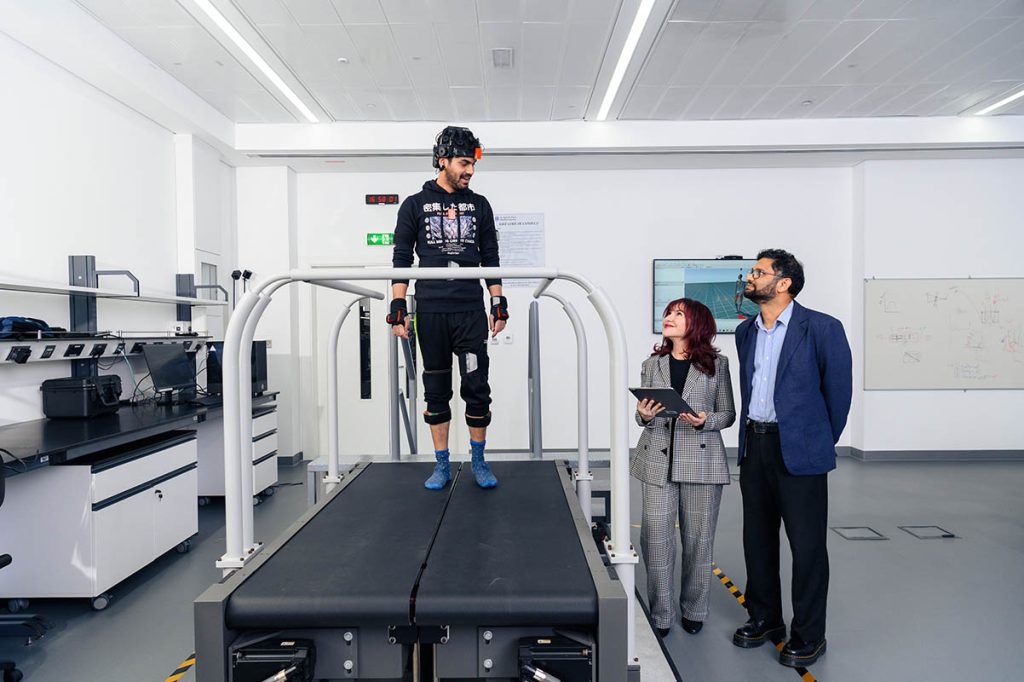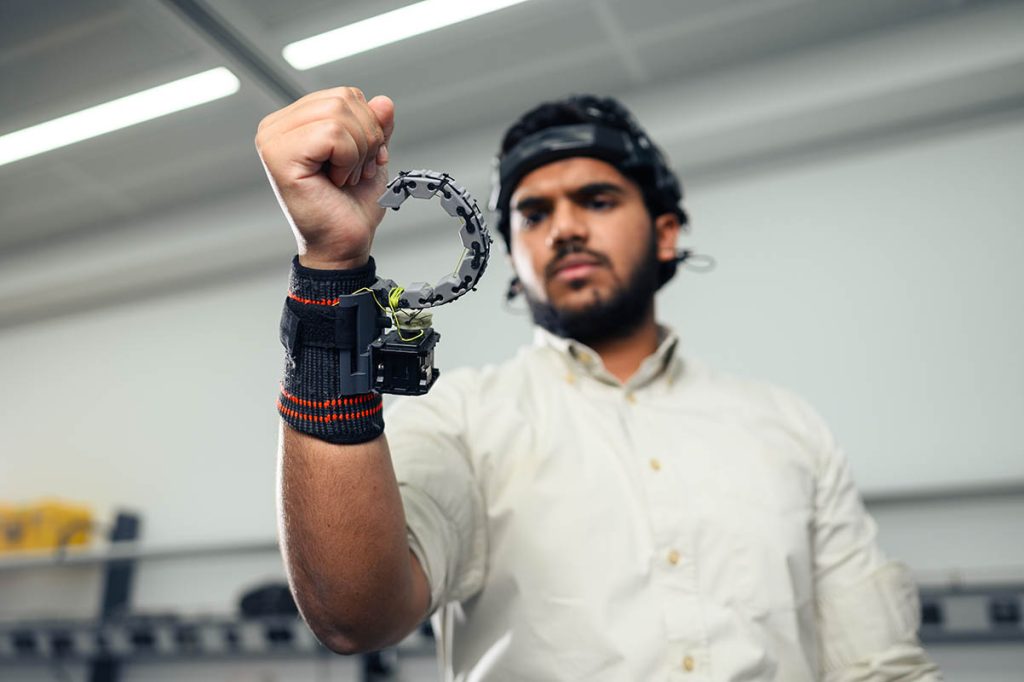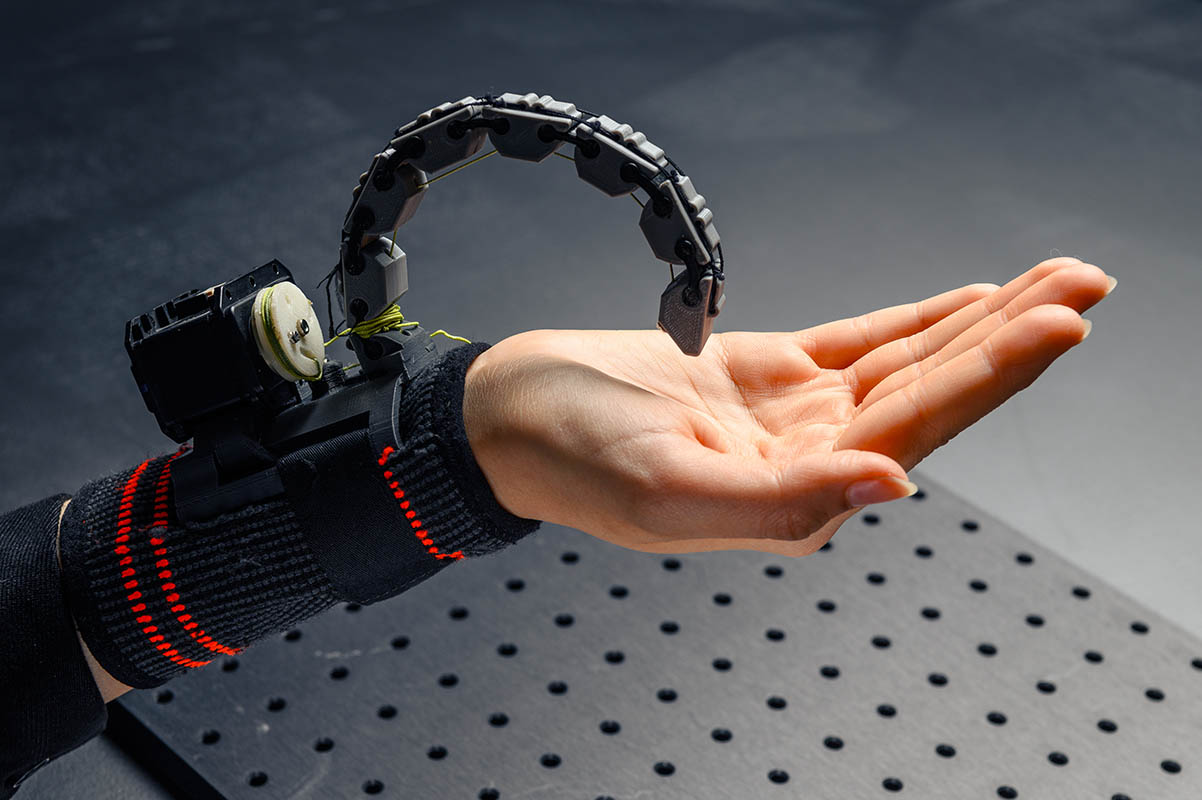Bridging the gap between healthcare innovation and technology in the UAE
The Healthcare Engineering Innovation Group (HEIG), a pioneering unit for medical device design, development and clinical testing, is transforming healthcare innovation in Abu Dhabi and beyond.
Globally, the usual age of a stroke victim is about 65. In the United Arab Emirates, it’s closer to 45. Doctors in the region say an increasingly sedentary lifestyle is to blame, alongside higher prevalence of obesity, type 2 diabetes and hypertension than the global average.
“Statistics reveal that every hour someone in the UAE suffers a stroke. This is quite devastating both socially and economically in a young country.”
Kinda Khalaf
Tackling this serious and emerging health crisis in the UAE is an important goal of an innovative research unit at Khalifa University that is developing new technologies to help boost healthcare. At the Healthcare Engineering Innovation Group (HEIG), researchers are working on techniques to diagnose, treat and rehabilitate patients in novel ways.
These include the increasing number of younger people who suffer a stroke. “Statistics reveal that every hour someone in the UAE suffers a stroke. This is quite devastating both socially and economically in a young country,” says Kinda Khalaf, Rehabilitation Leader at HEIG.
In her research, Khalaf uses low-cost, wearable sensors to accurately track how someone moves the different parts of their body to walk. The computerized gait-analysis technique can monitor and distinguish specific movements common in people who have suffered stroke, to help guide and improve their recovery. In conjunction with healthcare provider Cleveland Clinic Abu Dhabi, the HEIG team is capturing and integrating multimodal physiological signals, including electrical signals from the brain, heart and muscles, to provide a quantitative, head-to-toe, patient-specific description of the neuromusculoskeletal pathology.
“Conventional qualitative gait analysis, typically used in clinics, is mainly based on observational gait and is hence subjective and largely impacted by the observer’s experience,” she says. “Quantitative gait analysis, however, provides measured parameters, with good accuracy and repeatability for the diagnosis and comparative assessment throughout rehabilitation.”
It’s a smart, data-led approach that typifies the direction taken by the HEIG, which is guided by three key goals. The first is to achieve high-quality and measurable scientific output with high translational potential. Focusing on cardiovascular disease, the group’s researchers conduct world-class research that seeks to bridge the substantial existing gap in healthcare innovation and technology.

This research clusters in three associated fields, Khalaf explains: diagnostic engineering, minimally invasive therapeutic engineering and rehabilitation engineering. “Effective early diagnosis and immediate continuous monitoring can significantly improve mortality and morbidity rates, leading to longer independent living and a reduced use of healthcare resources,” she says.
The HEIG’s second goal is to build a strong human-capital base in Abu Dhabi and the wider UAE to provide a high-quality workforce who can use the medical technology applications the group will develop. To help build this capacity, HEIG—itself home to a world-class multidisciplinary team of researchers—collaborates with leading healthcare providers and regulators in the UAE, including Cleveland Clinic in Abu Dhabi, SEHA, Sheikh Shakhbout Medical City and Specialized Rehabilitation Hospital and the Abu Dhabi Department of Health.
The third goal for HEIG is to generate significant intellectual property, such as patents, with the potential for licensing and creating start-up businesses. Ahsan Khandoker, Diagnostics Leader at the group, has developed technology to help listen to the heartbeat of an unborn child. The signal processing equipment called Twinkle Heart is being commercialized by the start-up firm MARP (Medical Advanced Research Projects) Abu Dhabi. It helps expectant parents monitor their baby’s cardiac activity or simply listen to the heartbeat to feel connected and reassured. The device’s portability also makes it ideal for health workers in remote areas to monitor cardiac health in pregnancy.
The monitoring device has four sensors held on the maternal abdomen by a square fabric harness and elastic belts. “The center of the harness is placed over the mother’s umbilicus, which places the four sensors at equidistance from the center,” explains Khandoker. “This gives a very reliable measurement of foetal and maternal heart sounds, but without the need for operator skill in where to place the sensors.”
Such research in biomedical computing is “stimulating the budding culture of entrepreneurship and new ventures across the region,” he says. “This is opening avenues of development that could magnify the outcomes of the biomedical computing research community in the region.”
“There is currently no way of predicting when, how or whether a stroke patient will recover. This makes it difficult to decide which intervention is best suited to an individual patient.”
Mohamed Seghier
Researchers at HEIG have an advantage in such fields because they can access a range of cutting-edge equipment to test their ideas and generate the data to determine clinical benefits. In stroke for example, it is known that one-third of survivors achieve only a poor functional outcome five years after the onset, and although there has been great progress in managing outcomes, most of the care to reduce dependence among patients depends on rehabilitation. The HEIG team is looking at how robots could help this process, by assisting with the focused and repetitive exercises necessary to re-innervate muscles in the affected limbs.
“Newly emerged robotic rehabilitation has several advantages, including consistency of intensive rehabilitation for a longer duration, irrespective of the skills and endurance of the patient and therapist,” says Khalaf. “Robot-based systems have the potential to provide programmable movement patterns, control of movement repetitions, and real-time position and force measurement and tracking.” Robots can also be programmed to perform a wide variety of motion, including functional movements, she adds, so allowing the patient to perform autonomous and repetitive training on tasks that simulate daily activities.

“We are currently building exoskeletons and cable-driven robots for the rehabilitation of stroke patients, working towards leveraging the brain’s plasticity post-stroke. Smart sensors, novel AI-based machine and deep-learning tools, as well as virtual reality and serious gaming, are added to our platforms to provide the patients with personalized and culturally adaptive rehabilitation protocols,“ explains Khalaf.
“Our focus is on the design of micro-biorobotics and nano-smart drug delivery strategies for disease treatment, including aging-associated diseases.”
Sung Mun Lee
To complement this work, researchers at HEIG have harnessed technologies based on nanobiotechnology and drug delivery to address health challenges related to treatment, explains Sung Mun Lee, Therapeutics Leader. “Our focus is on the design of micro-biorobotics and nano-smart drug delivery strategies for disease treatment, including aging-associated diseases,” explains Lee.
In other work, HEIG’s director, Mohamed Seghier, is developing automated methods that can assess brain abnormalities caused by stroke as seen in clinical MRI scans. This could be an important way to distinguish the impacts and effects of specific lesions in the brain, potentially influencing the speed and scale of recovery. “Finding such biomarkers in clinical scans could offer doctors and patients a better sense of what sort of quality of life a stroke patient can expect,” he says. “There is currently no way of predicting when, how or whether a stroke patient will recover. This makes it difficult to decide which intervention is best suited to an individual patient,” says Seghier. This is especially important in the UAE as the relatively early onset of the disease means many stroke survivors can expect to live for several decades.
Aiming to transform the healthcare innovation landscape in Abu Dhabi and beyond by bridging the existing gap in healthcare innovation and technology, HEIG is addressing national health challenges, and working to attract external funding. HEIG is also expanding its research and innovation scope to address long-term aging and longevity challenges. Ultimately, the group aims to evolve as a pioneering self-sustainable unit for medical device design, development, and clinical testing. This is in line with Khalifa University’s mission of innovation and research excellence and with the broader strategic goals of the government’s Abu Dhabi Vision 2030.




